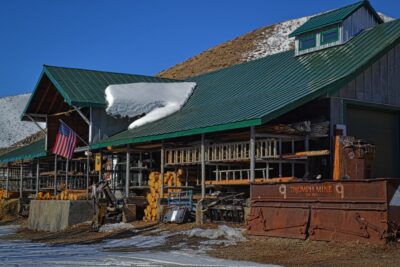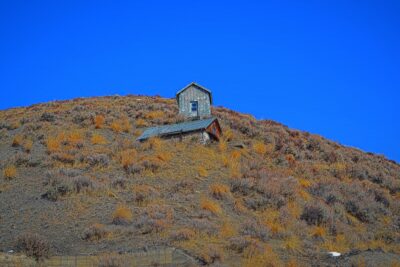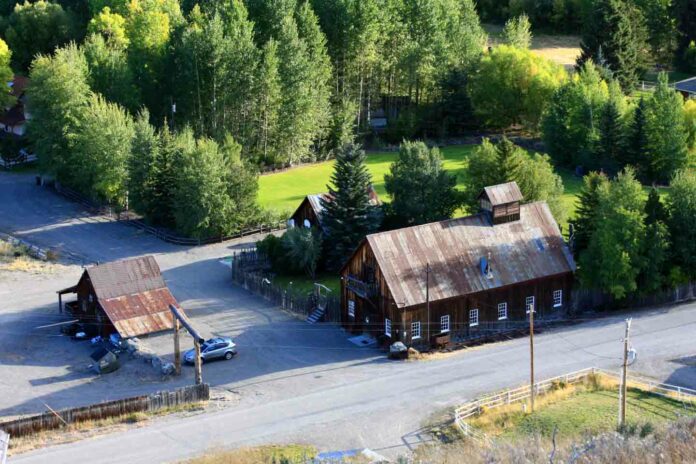From gold production to bankruptcy, this little town has a big history
By Karen Crowson

Twelve miles north of Hailey, on the East Fork of the Big Wood River, lies the unincorporated community of Triumph. Triumph was the location of the Triumph Mine, discovered in 1881 and that saw its first year of production in 1884.
Over the next 20 years, additional claims were grouped together, operating at 14 different mining companies, with the Philadelphia Mining and Smelting Company in Ketchum processing all the ore from Triumph. The Triumph Mine is located in the Warm Springs Mining District just over six miles northeast of Gimlet on the north side of the East Fork in the Wood River Valley and is a lead, silver and zinc mine.
The largest mining district in the Wood River Valley was the Warm Springs District. Three major mines supported this district, with these mines being the North Star, the Independence and the Triumph. Geologist C.P. Ross, with the Idaho Bureau of Mines and Geology, credits the district with over $3 million of combined metals from 1880-1902. The Triumph Mine was the greatest producer of all the early Wood River mining properties combined.
During the early 20th century, activity in the district gradually decreased and from 1902-1926 the district produced 6,069 ounces of gold, but with most of this production being produced from the Triumph Mine. In 1927, the Triumph Mine was re-opened by the Triumph Development Company, but before 1930 made its arrival, Triumph merged with both the North Star and Independence mines.
Seven years later, the Department of the Interior, under control of the War Department, stepped in to expand the Triumph Mine, building new offices, warehouses, a modern sink float mill, as well as a main tunnel 1.5 miles into the mountain. Shortly after, the Triumph Mining Company was formed, employing 200 men, with the mine operating 24 hours a day, but it was during the peak of WWII that the mine held the world record for zinc produced.
Records show that from 1936-1940 there were 409,458 dry tons of zinc produced, with a total net smelter return of $3,315,976.31. Production continued at a rate of 300 tons per day until July 1957, and it is recorded that $25 million of silver, zinc-ore and lead were produced from 1884-1957, while from 1932-1959 a total of 70,570 ounces of gold were produced. Other production records show for both the Mineral Hill and Warm Springs mining districts that from 1880-1970, more than 132,000 tons of lead, 135 tons of copper, 95,400 tons of zinc, four tons of gold and 828 tons of silver were produced.

From 1957-1959 the ore bodies were mined out and the mine closed. Incidentally, 1959 was also the year that silver, zinc and lead prices fell to half the WWII price while union labor also began demanding higher wages and, upon the closing of the mine, records show that from 1884-1957 there were 890 acres of mining operations, totaling 52 claims.
Sharon Blondin, Bellevue High school graduate of 1959 and resident of Murfreesboro, Tennessee, remembers her father, Albert Pascoe, going to work for the Triumph Mine when the Minnie Moore Mine closed.
“I remember the cave-ins and the people who died there,” said Blondin. “Mining was a tough way to make a living and it took a tough person to do it.”
Blondin, born in 1941, was from a large family, with seven siblings.
“We were poor,” says Blondin. “But everybody else was, too, so it was no big thing in that day and age to be poor, because most of the people were poor; they were miners and we were all miners and when the mines were closed down because so many people were killed, then there was no work. It was a hard life.”
In 1959, Rupert House purchased the Triumph Mine and in 1964 he formed the Triumph Mineral Company and became a Blaine County Commissioner, working the mine for 20 years after the Triumph Mineral Company began mining in 1970. House’s hope was to extract the value from the tailings left behind. The Mining Law of 1872 didn’t require the cleanup of mine waste and it wasn’t until the mid-1980s that the Idaho Legislature adopted mining reclamation laws.
Triumph wasn’t just home to the mines, but was also the birthplace of former World Cup alpine ski racer and Olympic gold medalist Picabo Street, born at home on April 3, 1971.
In 1982, the Getty Mining Company leased the Triumph Mine, extensively drilling and exploring the mine and tailings. The Getty Mining Company records show $45 million in gold left in the tailings piles.
Eventually, the government deemed that gold wasn’t a strategic metal and so it was of no interest to the War Department, and by 1988 requests to develop and subdivide Triumph were set in motion. Blaine County requested the Department of Environmental Quality investigate the area of Triumph. The DEQ performed one site investigation before turning the case over to the Environmental Protection Agency Hazardous Waste Site Unit, which listed Triumph as a potential hazard.
In the summer of 1991, the EPA conducted tests, checking levels of heavy metals in the soil, groundwater, air, and the tailings pile, and in October, EPA officials began informing residents of high levels of lead in their drinking water and high levels of arsenic in their soil.
Residents and children of Triumph gave both urine and blood samples over a three-year period to determine lead and arsenic levels in their bodies, but after the three-year study was finalized, the test results didn’t show any acute levels of arsenic or lead. The EPA allowed the State of Idaho to work with mining companies in implementing a cleanup rather than opting into the Superfund, since the 1993 proposal of the Superfund was rejected by both officials and residents in Blaine County.
In 1997, another soil study was conducted, with one sample showing 52,410 parts per million of lead and was the highest reading in Triumph. According to EPA standards, 400 ppm is considered hazardous in high-trafficked areas or around children; otherwise, the threshold is 1,200 ppm.
By 2003, the mine was plugged to prevent debris and contaminated water from flowing out of the mine. The DEQ reported the flow from the mine was reduced from up to 200 gallons per minute to up to 20 gallons per minute. It is estimated that $16 million was spent in remediating the mine’s tailings.
In 2007, the Triumph Mineral Company was sold to Carl Massaro, who renamed the company the Triumph Land Company. Massaro’s vision was in building a small solar village on the site of the old mill with a large solar collector but the vision never came to fruition. The mountain was sold in 2008 to DeNova, but the Triumph Land Company still owned the tailings, and in 2015 a second plug was installed at the mine.
In 2018, the Asarco Mining Company filed for bankruptcy, paying the DEQ $1.7 million to clean up the mine. The cleanup area covered 60 acres, which included the mine tunnel and tailings. According to the EPA, one million cubic yards of black sand was left over from the mine, constituting a health hazard because the sand was laced with lead, zinc and arsenic while the water from the mining area has an orange tint.
On May 29, 2018, Advocates for the West partnered with the Idaho Conservation League in sending a notice with intent to file suit to the State of Idaho. The notice to file suit was in regards to the Clean Water Act in belief that the state committed violations at the abandoned Triumph Mine. The Clean Water Act requires monitoring and cleanup of polluted water from mining sites before water flows into surface waters.
On September 14, 2018, Advocates for the West filed suit against the Idaho Department of Lands for illegally discharging arsenic and other pollutants into the East Fork without a federal permit. By October, a settlement was reached and on November 27, 2018, the court approved the settlement.
Both the DEQ and DOL applied to the EPA for a CWA permit and now regularly monitor the ground and surface water quality at the site. They have also installed warning signs near contaminated waters and have evaluated the need for additional fencing.
Today, Triumph’s population is less than 50 residents, with many only being part time. Many of the old mine workings can still be seen, and still standing today is the old miners’ barracks converted into a residential home while old weathered outhouses still dot the landscape of Triumph.



